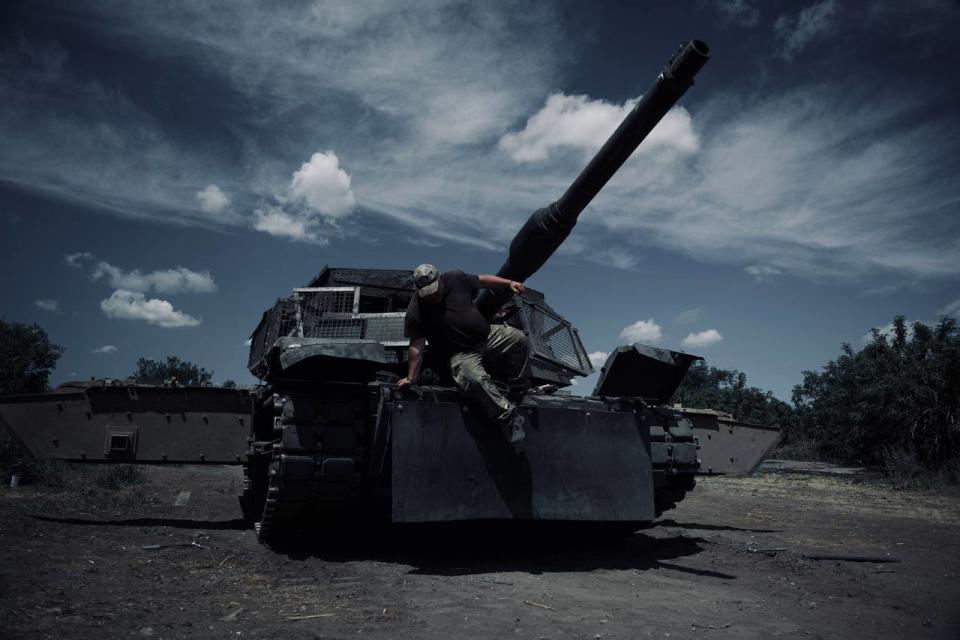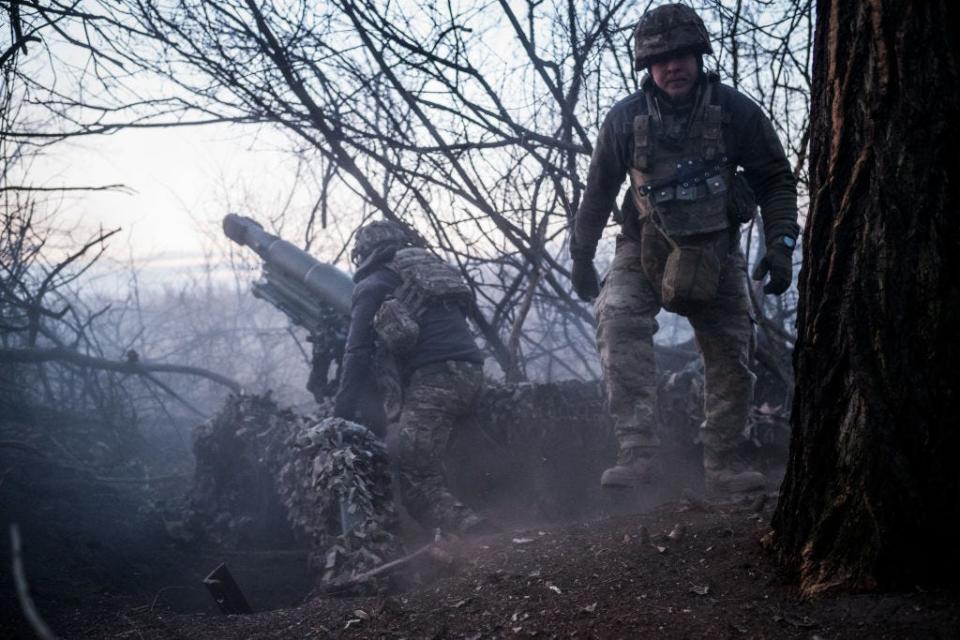-
Many of Ukraine’s Western weapons won’t make it to the end of the war if it really uses them, experts told BI.
-
Weapons like Abrams and F-16s have been given in small numbers, so Ukraine needs to take risks to maximize them, they said.
-
If any of them survive the war, “they probably weren’t used to their maximum extent,” a warfare expert said.
The brutal war in Ukraine is the kind of conflict that is going to consume the Western tanks and fighter jets sent if Kyiv’s forces really put them to work in battle, war experts told Business Insider, arguing that the West shouldn’t be surprised if none of them make it to the end of the war.
This is an intense, large-scale, protracted fight, and the Ukrainians need to make bold, high-risk, high-reward plays, they said. That doesn’t preclude caution, but using them to their fullest risks losses.
“If any of the F-16s make it to the end of the war, they probably weren’t used hard enough,” Michael Bohnert, an air warfare expert at RAND Corporation, said.
“I hate saying that,” he added, “but we as the West have to realize every Abrams tank that was given, every F-16, if any of them make it through the war, they probably weren’t used to their maximum extent.”
Ukraine’s Western partners sent fighters and tanks in small numbers, and those small numbers limit what Ukraine can do with the weapons. Maximizing potential means raising risks, and using them to their fullest is going to mean losses, especially in this kind of conflict.


William Alberque, a warfare expert at the Stimson Center, told BI that when it comes to Western weapons, “the maximization of potential means that a lot, if not all of them, may be destroyed.”
But if the weapons are “destroyed doing things that Ukraine could not have done otherwise and inflicting massive losses on Russia, then it’s entirely worth it,” he said. “We’re giving them with the understanding that we’re not getting them back.”
Risk is necessary
Alberque explained that “everything that we give Ukraine we have to assume can and will be destroyed in combat, but at the very least must be used to absolute maximum potential. And that entails risks.”
“And anyone who doesn’t understand that doesn’t understand the concept of generosity,” he said.
Bohnert noted that the Ukrainians do have to weigh the risk against “the propaganda that Russia will say: ‘Oh, we shot down F-16s. Oh, we blew up an Abrams, et cetera.’ But at the end of the day, this is winning a war and making sure Ukraine wins a war.”


Instead of being put off by the potential for Russian celebration, Bohnert said, “we in the West have to be willing to accept that none of those F-16s might come home. The pilots hopefully come home.”
“If you look at World War II, most of the planes that we started with didn’t end the war,” he added.
Ukraine’s forces have already lost some of their Abrams tanks, numerous Bradley fighting vehicles, a number of Leopard tanks, and at least one of its new F-16 fighter jets, at times leading to questions about the value of the support being provided, but war analysts argue that isn’t a reason for partners to panic.
George Barros, a Russia expert and geospatial analyst at the Insitute at the Study of War, told BI that “pointing at some destroyed Ukrainian planes and lost pilots and then coming away with the conclusion like ‘Oh, shoot, we can’t do this'” would be the wrong way to look at things.
He said that approaching it like that would be like Americans looking at what was happening “in World War II at the Battle of Britain and saying: ‘Oh, man, the Brits are losing a lot of Spitfires, why are we still sending the UK raw materials and weapons?'”
The conflict in Ukraine is a catastrophic, high-casualty fight that has claimed hundreds of thousands of lives, eating through men and equipment like the European continent hasn’t seen in decades, really not since WWII.
Bohnert said “that’s just sadly the nature of warfare, that a lot of people don’t come home. A lot of equipment never sees it through the war.”
In the West in recent decades, he said, “we’re used to wars where 5, 10, 20 people die a month,” wars like Iraq or Afghanistan, wars that, while tragic, didn’t come close to this scale.
“We’re used to these very low-casualty wars,” he said, “and that’s atypical in the history of mankind.”
The contrast between the slow, horrifically bloody, grinding war between Russia and Ukraine that has seen massive casualties and the recent wars the West has been involved in is one that many warfare experts have commented on, as well as fighters.


A US veteran who fought in Ukraine previously told BI that there are many Western fighters who come to Ukraine thinking it will be easy, but instead, they find that their training has not sufficiently prepared them for the intensity. Many have been killed as a result, he said.
The Ukraine war is a challenging fight where troops and equipment are consistently at risk because these assets are either shields or spears, either blunting a Russian attack or being used to break through Russian defenses, and that is going to mean losses if they’re being put to work.
Ukraine, for instance, lost its first F-16 during an air-defense mission aimed at protecting cities from a massive Russian missile barrage.
“If you’re a Ukrainian, would you rather have lost an F-16 or an orphanage? This is the way we have to start thinking. This is the way the West has to start thinking of aid: That it’s to win. It’s not for show,” Bohnert said.


Alberque said that for Ukraine, risks are necessary.
“You can ensure that you don’t lose any F-16s if you don’t fly any of them and you keep them in deep underground caves, but then what is the point?”
Not the best stuff
Ukraine only received a small number of F-16s, and so far, it has only received roughly a few dozen Abrams. With limited stockpiles, it has, at times, tried to play it safe.
Alberque argued that Ukraine should consider taking more risks with them, because with so few, “you better use them hard because you can’t hold back.”
Bohnert, likewise, said the West should allow Ukraine to take more risks with its weapons. He said the West, for example, should not restrict how Ukraine uses its F-16s, weapons that were first made by General Dynamics before that later passed to Lockheed Martin.
Denmark, one of the countries giving Ukraine F-16s, said that Ukraine can hit Russia with the F-16s that it gives the country, but other allies have not said the same.
Bohnert said “you should always allow someone to use their military in the most efficient way possible.”
Not only is this a war in which equipment will be lost if it’s used in battle, especially if it’s employed with a certain degree of risk, but it is also worth noting these aren’t top-of-the-line systems.
The Abrams tanks are older models without the top armor upgrades, and the F-16s are, too. These jets are capable fourth-generation fighters, but Western countries are already moving to new fifth-gen jets and researching sixth-gen options. The West isn’t losing anything in Ukraine it can’t afford to lose.
Alberque said that reality should motivate the West to support Ukraine in taking risks.
“We’re not giving them the best of the best of the best of the best,” he said. “We’re giving them the stuff that we think we can afford to give them. And for a lot of the European countries, this is stuff that they’ve already decided to replace.”
Read the original article on Business Insider
